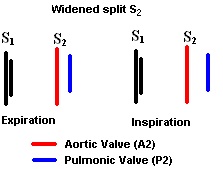General Cardiology Part 4
The second heart sound is produced by the closure of the aortic and pulmonic valves. The sound produced by the closure of the aortic valve is termed A2 and the sound produced by the closure of the pulmonic valve is termed P2. When these sounds are distinguishable from each other a split S2 can be heard. The patterns of splitting of the S2 heart sound include physiologic splitting, paradoxical splitting, widened splitting and fixed splitting.
Persistent (widened) splitting occurs when both A2 and P2 are audible (split) during the entire respiratory cycle, however the splitting becomes greater with inspiration (due to increased venous return) and less prominent with expiration. This differs from a fixed split S2 which exhibits the same amount of splitting throughout the entire respiratory cycle.
Any condition that causes a non-fixed delay in the closure of the pulmonic valve or early closure of the aortic valve will result in a wide split S2. Thus, a persistently split S2 occurs in the setting of a RBBB or severe mitral regurgitation. A RBBB causes a delay in the closure of the pulmonic valve and this a delay in P2 without any effect on A2. In severe mitral regurgitation (MR), the A2 occurs early secondary to a large proportion of the left ventricular stroke volume entering the left atrium, thus causing the left ventricular pressure to decrease faster. The P2 is not affected in severe MR.

